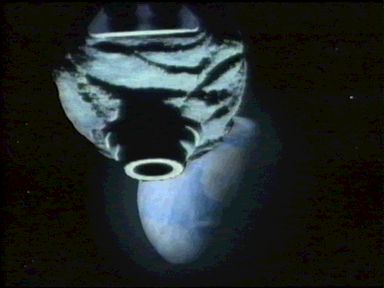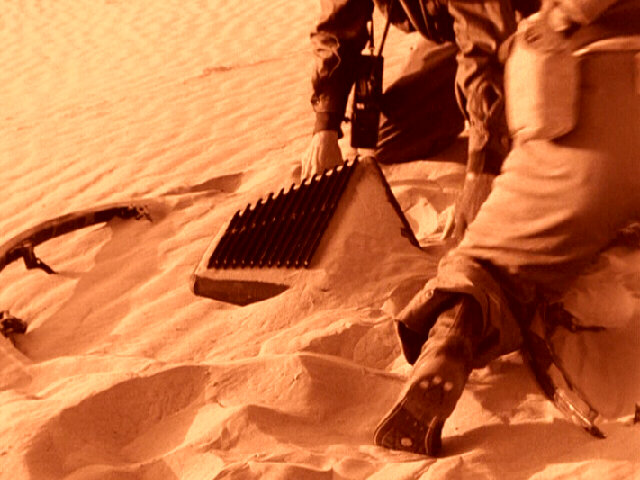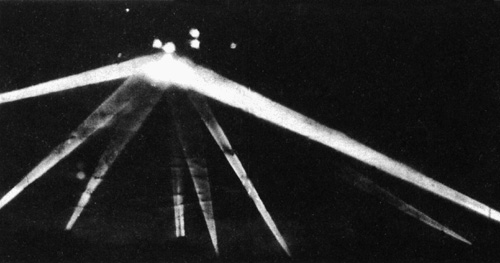THE CONTINUING SEARCH FOR THE ROSWELL ARCHAEOLOGISTS:
Closing the Circle

ALIEN ARTIFICIAL ARTIFACT SHOWN IN NEAR-EARTH PASS
the Wanderling
People are always calling into question events surrounding the alleged Roswell Incident, primarily because of a lack of hard scientific evidence that such an object suspected of having crashed could have existed in the first place. However, in the intervening years since the Roswell-crash technology and our ability in similar areas has advanced multifold. Where at onetime beyond earth potentials, either by us or by others, were the realm of science fiction writers, they no longer are. Now there are such things as Bracewell Probes from systems beyond ours as well as mysterious objects such as 1991 VG observed by well respected and qualified scientists:
On December 5, 1991 a mysterious object given the name 1991 VG, passed 51,000 miles beyond the orbit of the Moon, a distance from the Earth of about 288,300 miles. The estimated size of the object suggested a diameter from 33 to 62 feet. Small for an astroid, the object was said to not "act" like one either as it became three times brighter and then dark again every seven and one-half minutes --- behavior considered not unlike that of a rotating artificial satellite. At the speed it was traveling it wasn't long until the 1991 VG was well out of Earth's immediate environment, continuing, however, in a path around the sun similar to the Earth. Four years passed and for the most part the object was forgotten.
WHAT CAUSED THE UFO CRASH? THE GREAT 1947 SUNSPOT, ROSWELL AND CORONAL MASS EJECTIONS
It is a without a doubt that in many sectors of society the crash-event at Roswell clearly carries with it a certain burden of credibility --- that burden always leaning heavily toward the LACK of credibility side of things. To overcome that burden there have been a variety of attempts to interject, or bring forth to the public's attention, the involvement of high-level respected professional scientists into the narrative, especially in the early stages of the event. Such is the case with Roswell Archaeologists. The problem has been, except possibly for Dr. Lincoln La Paz two months after the incident, not one of the scientists, no matter how you write it, rewrite it, or parse the words, were actually involved in any sort of a formal dig of any kind related to the Roswell event. The best works and most thorough research on Roswell Archaeologists has been carried out by Thomas J. Carey. The following paragraphs regarding same --- and more specifically one William Lawrence Campbell also known as Larry Campbell and Cactus Jack --- have been excerpted from the much longer article by Carey as found on the net generally and attributed to the International UFO Reporter (IUR), Volume 19, Number 1; January/February 1994.
In the November/December issue I examined and rejected the
Barney Barnett story of archaeologists at the site of a downed UFO on
the Plains of San Agustin in July 1947. There is no corroborating
testimony for this event. But by rejecting the Barnett story, should we
altogether reject the notion of archaeologists as witnesses to a 1947
crash/retrieval in New Mexico?
Not just yet. In their 1991 book UFO Crash at Roswell, Kevin Randle and Don Schmitt devoted an entire chapter (pp. 113-117) to the search for the Roswell archaeologists. In addition to discussing the Barney Barnett story (which they have since rejected along with a Plains of San Agustin UFO crash), the authors mention three other accounts, one firsthand and two secondhand, describing apparent archaeological witnesses to UFO crash/retrievals. If not for these, I would have to conclude that the search was over and go home. The remainder of this article focuses on these additional archaeological witnesses as well as the case for a crash/retrieval in southeastern New Mexico during the first week of July 1947.
CACTUS JACK
A secondhand source named Iris Foster came forward as a result of seeing the Unsolved Mysteries show that featured the Roswell case and was interviewed by Randle and Schmitt for their 1991 book. The former owner of a cafe near Taos, New Mexico, she related that during the early 1970s (well before the publication of The Roswell Incident in 1980 by William Moore and Charles Berlitz) a fellow known locally as Cactus Jack used to frequent her establishment for coffee. He told a tale of being "out there when the spaceship came down" and seeing a "round object but not real big" and dead alien bodies "laid out." He described their blood as being "like tar" which stained their silver uniforms. I interviewed Iris Foster in 1991, 1992, and 1993 to learn more, if possible, about Cactus Jack. He was, according to Foster, "like a character out of a grade-B Western" with white hair and beard who could have passed for a prospector or a Pothunter (an amateur archaeologist) as far as she knew. His real name was Larry Campbell and he lived out of a camper when she knew him in Taos. She did not know the where or the when of his story but assumed that it happened a long time ago, most probably in the 1940s, so it is merely an assumption that he may have been talking about the Roswell events of July 1947.
In talking with Foster, I learned that she had a sister, Peggy Sparks, also of Taos, who remembered Cactus Jack. She recalled that he appeared to be in his late 50s when he was a customer at her sister's cafe. This means that he would have been in his mid or late 30s in 1947 and, were he alive today, would be in his late 70s or early 80s. In fact, Sparks stated further that Cactus Jack may indeed still be alive because, according to a lawyer friend in Taos, he was last seen in 1990 in the town of Las Vegas, New Mexico. She understood that he was burned in a fire in his camper and wound up in a state-run nursing home there.
Using various techniques, I identified not one but two "Cactus Jacks" residing in the state of New Mexico: One living "somewhere in New Mexico" according to his Albuquerque dentist son, and the other currently incarcerated in a federal prison near the Texas border for drug running. Unfortunately (or fortunately), neither's real name was Larry Campbell. As I later found out, the name Cactus Jack is commonly used in the Southwest to describe any number of scruffy-looking characters who look like they just stumbled out of the desert or from under their favorite rock, take your pick. My own mental image of Cactus Jack falls somewhere between Walter Brennan's portrayal of Granpappy Amos on the old The Real McCoys TV show and Gabby Hayes, the hirsute sidekick of the 1940s and 50s western movie star Roy Rogers.
Following up on the lead that Cactus Jack may have been burned in a fire in 1989 or 1990, Kevin Randle spent a day in Las Vegas, New Mexico, checking the local newspaper for a death notice or a reference pertaining to such a fire. Nothing. After several failed attempts, I was finally able to get someone at the state-run nursing home in Las Vegas to check their records to see if a Larry Campbell was ever a resident there. After a few minutes' wait, they responded that they had no record of such a person there.
There matters lay for the better part of last year until, following a talk on Roswell that I gave in Alamogordo in November 1993, a member of the audience came up and introduced himself as someone who might be able help me find the Roswell archaeologists. Although he was not specific, he said that he had sophisticated sources and databases at his disposal that might be brought to bear in the search. Not wishing to give away the store by divulging any of the archaeologists on my hot list, I gave him the task of trying to locate or otherwise determine the current status of the elusive Cactus Jack/Larry Campbell. There is nothing to report as yet, but one can hope that something will turn up one way or the other. Realistically speaking, however, Cactus Jack is an investigator's worst-case scenario and a long shot at best: no known residence, no known employer no known friends or relatives, nothing. Chance may intervene as it has already done elsewhere in this endeavor, but I do not expect further developments in the Cactus Jack saga.
Thomas J. Carey, January/February 1994

ONCE UPON A TIME: CACTUS JACK, SPACE ALIEN ARCHAEOLOGIST
(please click image)
NOTE:
It should be brought to the attention of the reader that since the publication of Carey's 1994 article above, Kevin Randle in his book The Roswell Encyclopedia, published in the year 2000, on page 73, states that Carey had since learned that Cactus Jack died. Carey eventually located a Taos newspaper article that confirmed Cactus Jack had been injured in a fire, although if the fire and Campbell's death were actually related in some fashion is not revealed. Accompanying the article, according to Carey, was a photograph of "Jack" wrapped in bandages. According to Randle, Carey was also even able to obtain a copy of Cactus Jack's last driver's license.(?)
For NEW and addtional insights into Larry Campbell, AKA Cactus Jack that have come to light since Carey's and Randle's 1994 and year 2000 now nearly 15 year old research, and any level of involvement Campbell may or may not had as an archaeologist or otherwise in the Roswell UFO crash, please see William Lawrence Campbell and/or The Pothunter.
For the other major suspect, and thought to be the MOST LIKELY CANDIDATE for being THE Roswell archaeologist, see the William Curry Holden link below as well of that of C. Bertrand Schultz. Schultz, whose revelations regarding Holden being the one and only archaeologist are thoroughly substantiated in:

